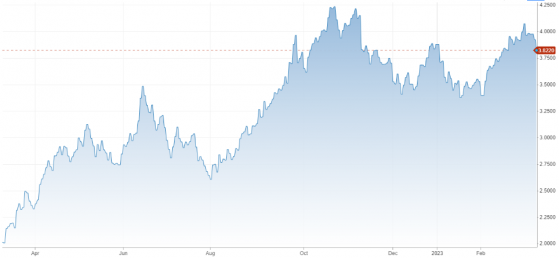Silicon Valley Bank’s ongoing crisis has brought one bugbear of the cryptocurrency market’s 2022 rout front and centre of the traditional financial sector: Market contagion.
A byproduct of interconnected financial systems, economic fragility and all-round tetchy sentiment among financial investors, contagion tends to rear its ugly head in a multitude of ways.
In relation to the ongoing crisis at SVB, Silicon Valley’s largest bank has undoubtedly hit wider financial sector valuations.
US banking behemoths Bank of America (NYSE:BAC) and Wells Fargo (NYSE:WFC) saw their shares drop more than 6% following SVP’s asset fire sale; Wells Fargo and Citigroup (NYSE:C) fared little better.
Admittedly, these downgrades sound like a drop in the bucket to SVP’s 60% freefall, but their combined losses in dollar terms exceed US$52bn (£43bn).
That’s around five times the entire market valuation of SVB pre-crisis.
Now the disease seems to be spreading to London, with Barclays (LON:BARC) and Lloyds (LON:LLOY) down 3%, HSBC down 4.5% and Santander (BME:SAN) down 6%.
In Frankfurt, Deutsche Bank (ETR:DBKGn) is down nearly 8%.
All because of a mid-sized bank to the US tech sector. But the stakes are higher than SVB’s market capitalisation suggests.
Bonds, lame bonds
When SVB made an ill-fated decision to ask the market for US$1.8bn through an equity raise on Wednesday, its prospectus disclosed that it made substantial losses through the sale of Treasury bonds.
In the prospectus’ words: “Earlier today, SVB completed the sale of substantially of its available for sale securities portfolio. SVB sold approximately US$21bn of securities, which will result in an after-tax loss of approximately US$1.8bn in the first quarter of 2023.”
Unfortunately for SVB, its fire sale came at a time when soaring Federal Reserve interest rates pushed the price of bonds significantly lower, causing realised losses on its investment portfolio.
US 10-year Treasury bond yields go up as prices go down – Source: cnbc.com
This caused the market to think… Shit, who else has most of their investments in government debt? What will happen if they need to shore up cash? They could lose billions!
Spooked investors thus applied fresh risk discounts on their shares in Wells Fargo et al and headed for the doors, tanking shares in the process.
As explained by Russ Mould at AJ Bell: “Lots of banks hold large portfolios of bonds and rising interest rates make these less valuable – the SVB situation is a reminder that many institutions are sitting on large unrealised losses on their fixed-income holdings.”
Sound familiar?
If SVB’s rock-and-a-hard-place position sounds familiar, it’s probably because barely a day earlier, a similar thing happened to Silvergate Bank, another California-based financial institution.
Silvergate Bank was forced into voluntary liquidation on Thursday after suffering around $886mln in realised losses on its bond portfolio, for it, too, was forced to sell the at a discount to satisfy withdrawal requests.
It was far from the only issue facing Silvergate and we shouldn’t get too caught up in finding a common thread between the two; Silvergate Bank died largely because was a bank to the cryptocurrency sector whereas SVB is focused on the broader tech sector.
SVB has also not entered administration.
Silvergate Bank: End of the road for decade-long crypto experiment
But there are similarities to be made. Both made the mistake of investing in long-dated securities with short-term borrowings from insolvency-prone companies.
Deflated in price due to rising interest rates, those securities simply weren’t/aren’t liquid enough to satisfy withdrawals.
Bloomberg’s Matt Levine summed it up best in his Silvergate post-mortem: “If you borrow short (a bunch of deposits from flighty crypto firms) and lend long (buying long-dated mortgage-backed securities, etc.), that is the risk that you take: Rates go up, people ask for their money back, you have to sell your assets, but they have lost value and you are out of money.”
Market contagion is often self-fulfilling: Institutional investors get spooked, sell, shares dip a little, more investors sell, shares dip even further, more investors sell, and so forth.
Unfortunately, the only vaccine is to cross your fingers and hope for the best.
Read more on Proactive Investors AU
